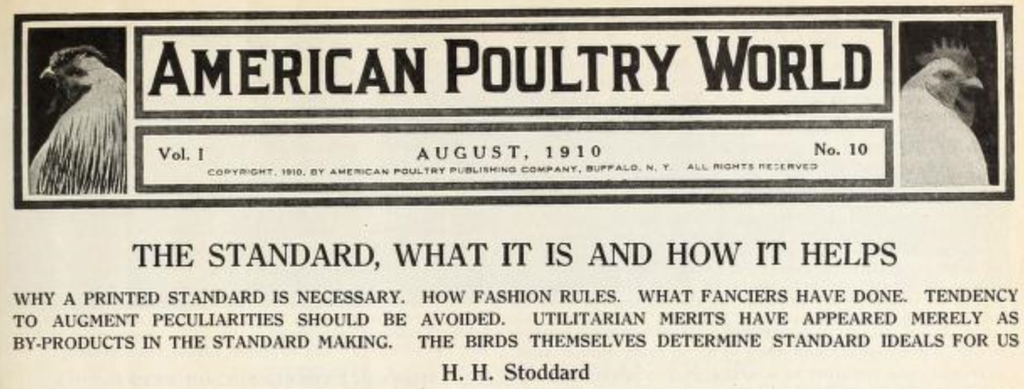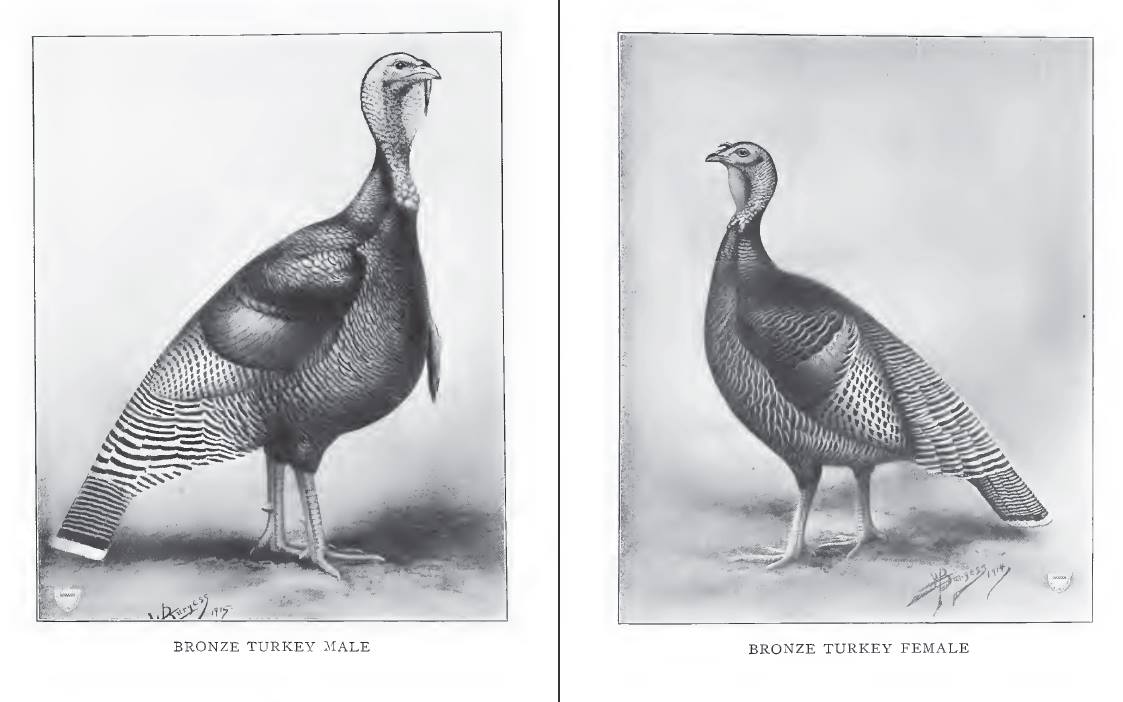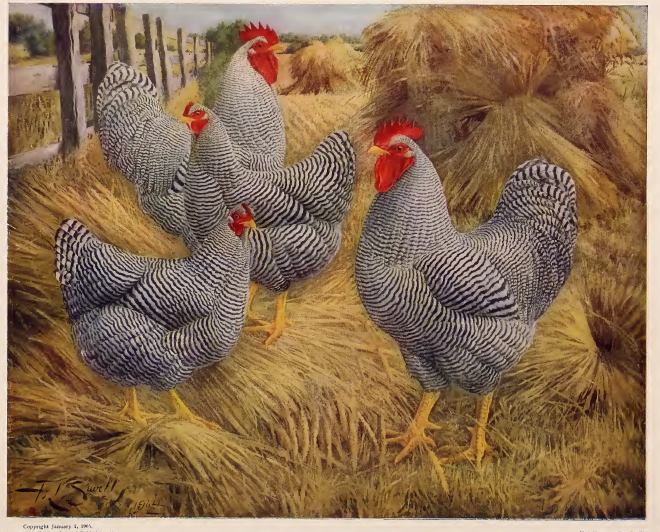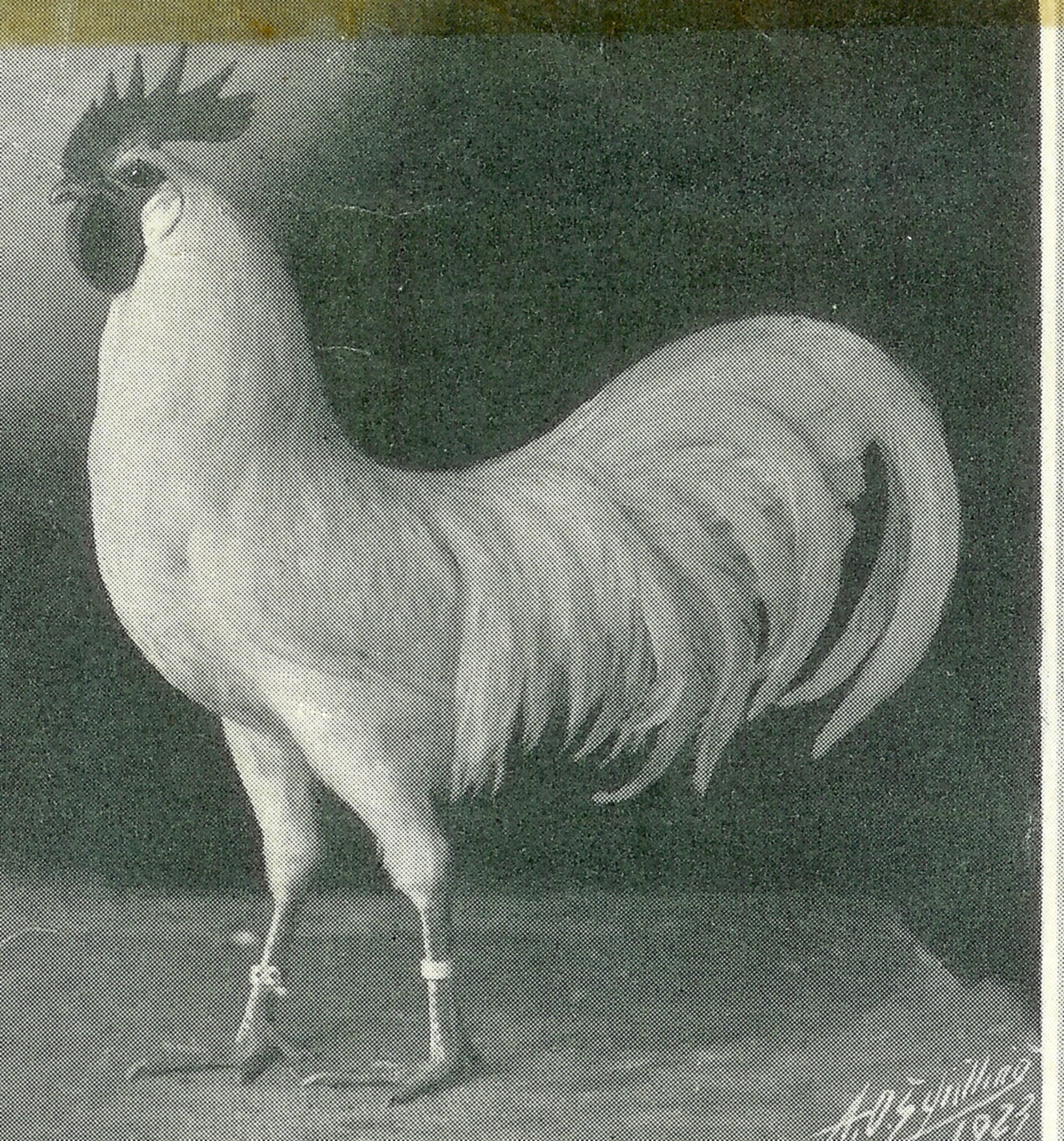This is a reprinting of an article by Mr. H. H. Stoddard regarding the history and his views on the Standard of Perfection
Through the years there have been several milestones in the history of the Standard of Perfection. Some have generated controversy, some have corrected previous wrongs and some were simply updates from prior editions. But regardless of that, all are interesting!
Each section was reproduced here as accurately as possible, even those with a negative edge. The article on the 1910 Standard of Perfection revision barely hides the author’s contempt for the American Poultry Association’s “new” Standard of Perfection, yet it gives a clear view of what was occurring behind the scenes.
Before you delve into the various Standards maybe you are asking why a Standard of Perfection is even needed. Below is an excellent, though at time tongue-in-cheek, article by Mr. Stoddard, editor of American Poultry World.

Curious isn’t it, that without competition in the show room, or its equivalent elsewhere, no distinctive breed of any sort of domestic animals, whether biped or quadruped can, ordinarily, be preserved in its purity for any considerable length of time? And if, as might happen rarely, a pure breed should be preserved and improved by some zealous experimenter, the fruits of his labors would be lost before they could be given to the world, were there no show rooms.
Printed Standard of Perfection Necessary
When a breed comes to us already formed, as for in-stance when Shanghais, Hamburgs or Leghorns were brought here, its fate always is to “run out” ultimately, by mixing with the common fowls of the country, unless there is exhibiting done which compels purity of blood, and also the various improvements, on foreign stock or on breeds made up here, disappear sooner or later, unless under the care of exhibitors.
Now, as the show room is impossible without judging and judging to amount to anything is impossible without a printed Standard of Perfection, it can be demonstrated that the great livestock interests of the whole world, embracing the four footed animals as well as poultry, rest on—what? A system of rules, mostly or largely arbitrary, often frivolous, and substantially a code of fashion, as was set out in the April number of this magazine, page 422, column 2, and the statement that a Standard bird means essentially a bird fashionable in shape and color is even truer nowadays than when it was uttered many years ago. Truer now, because in the nature of the case, as we shall show later on, the longer a breed is exhibited, the more arbitrary and purely artificial its Standard requirements generally become.
Standard for Cattle Originated with Poultry Standard
The statement that the breeding and preservation of improved poultry and larger domestic animals both rest on competition in the show room recalls the fact that judging by systematic printed rules and the use of the score card was first applied to poultry, and that exhibitors of more pretentious livestock took the hint.
American poultry people will historically everlastingly be entitled to the honors of pioneers in this matter. Now consider for a minute the enormous attendance at national, state and county agricultural fairs, all over this immense country, and what these imply in labor and expense, and then imagine Halsted and Lockwood with their modest little books, and just after them Felch, the builder, ingenious always, with his primitive score card, and consider how these men did not know at the time what a conflagration was to spread from the little flames they started. Columbus himself once appeared about the same as other babies.
Fashion Rules no More in Fancierdom than Elsewhere
Felch in his later days is bemoaning the decadence of certain once noble breeds of birds after they have been subjected to exhibition ordeals for forty years, and now I shall be accused of like treason in giving away that our Standard is four-fifths if not nine-tenths purely conventional and arbitrary, and often absurdly frivolous fashion. But hold on a minute. The world of humanity moves on lines of fashion and changeable fancy, in everything, just as planets and comets are bound to move on certain lines.
In matters of government and law, religion, creed and rules of morality, manners and customs, educational systems, bringing up children, industrial methods and business practices, and in everything human under the sun, appears the inevitable law of fashion. It is then no reproach that our poultry Standard is a code of fashion. It would be little short of a miracle were it anything else.
Walk down the street with me, across there is a furniture factory and most of the workmen in it have never seen the pattern of bedsteads, dressing stands and sideboards made there a while ago, and the appliances for making them have been sent to the scrap heap. A bedroom set that cost say $80.00 only forty years ago is now considered an “antique” because those fifty, eighty or more years old have been bought up, so this today brings $150.00 or more to furnish a room “old style” for somebody because there is a fad among some wealthy folk to have such rooms. In fashion, out, then in. “Off again, on again, gone again, Finnegan.”
Further on is a boot and shoe factory. Bless me, why cannot folks, when a neat, good looking, sensible, easy-fitting shape of shoe has been devised, be contented with the same pattern for a life time? But they won’t, and the enormous expense in changing styles is just like throwing so much good money into the sea. It is a sacrifice of human toll on the altar of fashion.
Yonder is a tailor shop and also a millinery establishment. Thousands of them, all over the country. The cost of the changes of style they represent would more than feed all the poor and support all the schools. The millinery factory is to achieve the very acme of waste, the most costly sacrifice on the altar aforesaid. Yet you, my reader of the male persuasion who laughed at the newspaper quirk of the woman at church to whom “the consciousness of wearing a well-fitting gown of the latest style gave a peace of mind which all the consolations of religion could not bestow;” after all, you dastard, you would be ashamed to be seen in the same church encased in trousers of a model of three years ago. You could not be hired, for any moderate sum, to walk up Main Street sporting one of the stovepipe hats, curiously shaped concerns, once common in business hours as well as on occasions of ceremony.
Change for the Sake of Change
Not all the changes fanciers bring about are improvements. In fact, very few of them are, just as may be said of changes in women’s head gear which sometimes progresses from one form of ugliness to another still more hideous. As it was in the beginning, it is this minute, and evermore will be while a poultry exhibition or a millinery shop exists on the face of the earth.
The great solid benefits bestowed by fanciers upon the public at large are, first: the importations or valuable breeds from various parts of the world, their characteristics having been fixed by the people of the district where procured and unwittingly in the main and by climatic and other local natural influences during long centuries; and, second: the preservation of these breeds i.e. the keeping them unmixed with other pure breeds or with the common fowls as before remarked.
The whimsies and costly extravagancies that go along with this solid beneficence are, as we have seen, inseparable from the doings of men and women no matter what field of human endeavor is examined. When the flub-a-dub of the exact length at neck, shape of back and curve or sickle is ridiculed on account of the enormous cost of labor and money they represent, it should not be overlooked that this lavish expenditure of effort helps indirectly to put “better poultry and more of it” on every dining table.
It was once bewailed by a writer that the porcelain establishments squandered so much money on extremely costly pottery for the wealthy, but another writer promptly showed that by the processes and improvements devised to cater to the rich, the firms were able to put better and cheaper ware than before upon every poor man’s table.
The fancier is never contented. If he should be it would be the “death of the fancy”. If the Standard of Perfection requirements were easy-and this point is invariably brought up by somebody whenever there is a revision of the book —Tom, Dick and Harry could breed up to them, and this would be the close of the sport, the paralysis of endeavor, the end of high prices which are necessary to pay the piper, and the sounding of the death knell of interest in exhibitions. The Standard of Perfection is a musical instrument which must be kept keyed up to a high tension or there will be no more good music.
It is a curious thing that in the fancier’s mind there grows up, while he is very likely entirely unaware of it, a great partiality for a particular feature or trait, and a tendency to try to emphasize it in breeding. It was noticed, during the first few years of shows, and often remarked that if a Leghorn man or a Game man who did not keep Light Brahmas was called upon to judge them (makeshifts often had to be resorted to in those times) he would give preference to the long rangy birds; but a Cochin man, on the contrary, preferred unwittingly the more blocky shape and there was much discussion of the matter at a time when the Brahma was often pretty leggy as if remembering the old Shanghais that preceded him, and many breeders were trying hard to tone him down to more symmetrical proportions.
In my personal experience, for years while not keeping pigeons, I looked on every variety of these birds, at the shows, bar none, as, in a degree, artificial monstrosities: and the common birds of the streets, essentially the wild rock pigeon, as the model of beauty devised by nature through ages for grace of form and sprightliness of movement. After a while I kept Homers, and without realizing that I was forming a new taste, I became more and more interested in watching the birds which betrayed the characteristics of the breed in the most pronounced form. The Homer’s beak is really deformed and ungainly, but it began to appear highly desirable to my eyes, I admired the long wings and rakish body and never suspected that I was going back on my old favorites, till chancing to watch one I gave a start to find myself criticizing its dumpy shape.
Tendency to Augment Peculiarities
In the nature of the case, the fancier tries to intensify a feature that is already abnormally developed. If the Japanese have, in a few hundred years more or less, or say a thousand or two thousand years, succeeded in breeding chickens with tail feathers twenty feet long, and which have kept on growing unshed for several years, fanciers of this sort of thing will most assuredly try to attain twenty-one feet and to lengthen the period for the feathers to remain unshed. And where is the limit?
Physical traits are indefinitely modifiable but not inimitably modifiable. When the strain on the bird’s system by this abnormal development, or some other influence the nature of which may be obscure, shall intervene, the process will have reached its limit. There are so many things demanding the attention of rational people that it is pitiable, if not worse than that, to see time wasted on such whimsies.
Darwin shows how natural and inevitable it is for dog fanciers, or rabbit, pigeon or poultry fanciers to run to extremes in the cultivation of unusual shapes, or the characteristics of any kind which principally distinguish the variety they are breeding,. All this is well enough, in a way, but should not be carried too far. Their proverbial utilitarian sense checks Americans somewhat, but the English keep on increasing in degree the peculiarities of certain breeds of fowls till in some cases perfect monstrosities result which their creators consider perfect beauties.
Wot ye not, however, that such practices are actually scandalous and tend to bring the whole poultry fancy into disrepute? Life is too short, anti should be too earnest, for the pursuit of such valueless objects as the distortion of features nature was building up for ages, and which, in their normal state have a use and a meaning which we had better admire and preserve rather than destroy.
What is Excellence or Perfection
The Standard was formerly called the “Standard of Excellence” but once on a time I introduced a resolution in A.P.A. substituting the term Perfection which carried. The members agreeing without any dissent that the specifications in the book described a perfect bird, according to the fanciers notions as to what constituted perfection, and did not describe a specimen possessing merely excellence for there might be many degrees of excellence in various birds, none of which reached perfection, while on the other hand, perfection could not imply degrees. The perfect bird is the ideal bird and an ideal bird is a perfect bird.
But what is the ideal? Well, in the first place, if we were considering a Standard for a breed, say the Leghorns, the first notion which comes to the mind of the Standard of Perfection maker is the original main type the birds had when they were first imported, the features which principally distinguish them from other breeds. I am using the word breed in a wide sense just now, including all the Leghorns irrespective of color.
The features not due at all to American breeders, but which were impressed in the old world during thousands of years before an American saw them—these features constitute a type marking them off from all other fowls. The main features then, of the Standard of Perfection for Leghorns, constituting its skeleton or frame work, were specified in accordance with the distinctive type the birds possessed before any American attempted in the least to modify them.
Aside from these prime features there appeared minor ones, differing somewhat in different specimens, and the Standard makers elected to approve this, and discard that and the other, till a pretty full description of an original Leghorn appeared in the Standard of Perfection. But as time rolled on, in accordance with the tendency of fanciers to intensify traits, of which we have spoken, the main features of the breed were tampered with and modified in various ways. But to say that Leghorns are an American breed and made in America is incorrect. Modified here they have been, but to call them an American breed, as has been done, is an abuse of language.
Now in case of cross-bred birds, like Rocks, the sequence has been as follows: First, by accident or design, two or more breeds are mixed and among the diversity of styles which usually appears in the progeny when there is crossing, if not in the first, that in later generations, some type is selected, either because it is the most common, or seemingly the most desirable, or mayhap for both reasons, and this type when selected and elected is studied to read its chief characteristics before writing a Standard for it, just exactly as original imported breeds would be studied for the same purpose. The main peculiarities having been duly chronicled, minor details are, in the first instance, and in later years also, dealt with in just the same way as in the Leghorn case.
In the first place then the birds speak for themselves and in many things they determine our ideal for us, while in some other things our pure fancy or preference does the work of Standard making.
It is continually asked what are the chief features established in the Standard, are they founded on notions of good looks or utility or both? Anxious to stand well with the Great American Public, the A. P. A. members often hasten to answer “both.” But alas! Candor compels me to declare that first, last and all the time the Standard has dealt principally with external appearances and mighty little with intrinsic or more properly utilitarian merits. These last have been fostered only incidentally for the most part. Though extremely important, they have appeared merely as a by-product.
The imported breeds were recognized as particularly valuable acquisitions in regard to eggs or flesh and this recognition prompted or hastened their admission to the Standard. It is true; that the Standard describes their external appearance and not the utilitarian merits aforesaid. To be sure there is much glorification over the alleged fact that this shape or the other denotes vigor and constitution, “lung power” and so on. But the boasted shape depends on feathers, not on flesh and blood in many instances, and after years of cultivation of the plumage you could not tell the difference as regards shape of the body, given that the cultivated and uncultivated birds were both denuded of feathers, dressed, and laid on a platter “side by each”.
Would you belittle the Standard then? Not at all. Did I not say at the outset that a Standard is the cause of, and the key to, the preservation in their purity, and the dissemination of, all the valuable breeds not only of fowls but of all races of domestic animals, and did I not point out the great fairs as an index of the enormous livestock interests they represent, the immensity of which words cannot describe?
True, there is lots of fol-de-rol about the Standard, but so there is about everything which poor man does. Even our courts for instance, and the methods followed in cases the-most grave and important conceivabl, are full of arrant humbug.
I do not forget that condition and size held places from the first, in the Standard, but a prize winning breeder of Partridge Cochins or of any breed demanding great nicety of markings may (confidentially) tell you that to secure this nicety, he must in-breed till size is impaired, and sometimes constitution is and the birds live on the By-Laws.
Thus, conformity to the Standard of Perfection in securing one requisite impairs another requisite denoting health and strength. As regards “condition” what does that part of condition amount to so far as utility is concerned which consists in cleaning the feet of a bird designed by nature to dabble in filth? Clean feet are really of prime importance though, as helping the looks of a show. What does the appearance of feathers, bleached artificially, signify, or if the bird has been deprived of sun and air to keep its plumage from fading, how much strength and vitality does that practice promote?
Utilitarian Points not for the Show Room
I must hasten to close this paper before it becomes too lengthy, reserving other Standard matters I would like to set out till another time. It must not be thought that I would have utility occupy a large place in the Standard and in judging. This would be impracticable. Already the judge can decide on the health of a bird by outward signs, and the scales serve another important purpose of a utilitarian nature. But the kitchen and the cook cannot be used to test the quality of a fowl while it is alive, and the laying qualities of birds would have to be judged on the strength of statistics furnished by their owners, who average up, no doubt, as honest as millionaire tax payers do, and are no more honest.
But if the exhibitors lie half as badly about the number of eggs as the others lie (or connive in ways that practically amount to lying) to get rid of being fairly taxed, then the biggest liar at the show gets the biggest honors.



